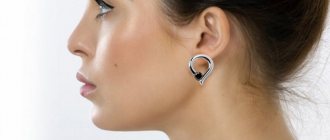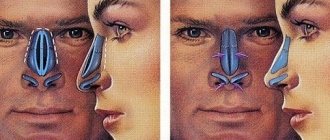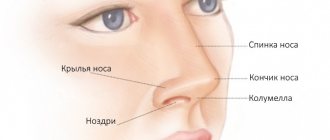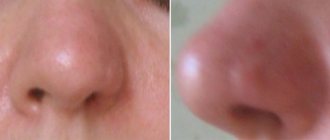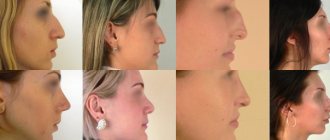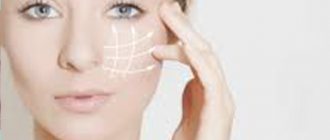- Advantages and disadvantages of non-surgical rhinoplasty
- Indications and contraindications
- Fillers used for nose correction
- Belotero Intense
- Juvederm Ultra 3
- Juvederm Ultra 4
- Neauvia Intense
- Teosyal Ultra Deep
- Teosyal Ultimate
- Restylane Perlane
- HyaFilia M
- How is the procedure performed?
Reshaping the nose is one of the most popular surgical procedures.
In some cases, it is possible not to resort to surgery, but to correct the contours using injections. The essence of the method is to introduce hyaluronic acid-based gels under the skin. In this way, you can smooth out irregularities and eliminate asymmetry, and increase the volume of your nose in the right places.
Important! For those who need to make their nose smaller, this method is not suitable: this problem can only be solved with the help of plastic surgery. But it is quite possible to remove the curvature, make the nose more even, and hide the hump.
What are the benefits of hyaluronic acid fillers?
- No side effects (allergic, toxic, etc.) to the drug due to its identity with the skin’s own hyaluronic acid;
- The drug is completely absorbed (from 6 to 15 months).
The drug Radiesse (calcium hydroxyapatite) has proven itself well. Its advantages: longer resorption time (2-3 years), less hydrophilic compared to hyaluronic acid preparations (in areas prone to swelling). The drugs differ in viscosity, hydrophilicity, stability and other parameters.
Advantages and disadvantages of non-surgical rhinoplasty
Nose correction with fillers has an important advantage over classical plastic surgery - the procedure is reversible. Fillers dissolve after 9–20 months, and the nose regains its previous shape. The process can be accelerated by introducing a special enzyme - hyaluronidase. If desired, you can make the correction again.
The second significant advantage is the low invasiveness of the procedure. Injections take a minimum of time, and recovery takes 3 to 4 days. This cannot even be compared with rehabilitation after surgical rhinoplasty. No preparation is required either, and the list of contraindications is very short. No marks are left on the skin.
There is only one drawback to such an intervention - it will not be possible to radically change the shape of the nose and reduce its size.
Indications and contraindications
Nose contouring is a cosmetic procedure; there are no medical indications for it. Injections help eliminate cosmetic defects:
Indications;
- Asymmetry;
- Humps;
- Lack of volume;
- Curvatures.
Contraindications are the same as for other types of contour plastic surgery:
- Autoimmune and oncological diseases;
- Exacerbation of chronic diseases, acute diseases;
- Rashes, dermatological diseases in the treatment area;
- Pregnancy, lactation;
- Tendency to form keloids;
- Blood clotting disorders.
Important: before the procedure, you should not drink alcohol or drugs that affect blood clotting.
Result
Such rhinoplasty without surgical intervention immediately changes the appearance for the better, and the final aesthetic effect can be seen after just a few days, when the false volume caused by swelling has completely disappeared. This minimally invasive method corrects a number of defects :
- depressions, irregularities and asymmetry;
- drooping, ugly upturned, too thin tip;
- the back is flat or with a hump;
- irregular shape of the bridge of the nose;
- scars, unaesthetic consequences of injuries and operations;
- saggy, flabby soft tissues.
In these cases, a targeted impact on the problem area allows you to avoid a more traumatic operation. If it is still necessary, the corrective procedure offered by the CONSTANTA Clinic, which is temporary, that is, reversible, will make it possible to see whether the surgical intervention will bring the desired aesthetic effect. Also, the technique should be used in cases where the operation is currently impossible due to medical contraindications or the patient has not reached the age of majority.
Effect duration
How long the corrective effect will last depends on:
- the selected drug;
- the nature of the problem being solved;
- individual characteristics of the patient's skin;
- his age and lifestyle.
The choice of a cosmetic product and the accuracy with which it will be introduced are determined by the professionalism of the doctor performing the manipulations. Qualified specialists of the CONSTANTA Clinic, who have undergone the necessary training and are fluent in the technique, will perform a procedure that guarantees the longest lasting effect. We use substances specifically designed for this purpose, which have proven their safety in a number of clinical trials and have received favorable reviews from our patients.
The average resorption time for fillers is 8-12 months. It depends on how quickly your body processes the received substances. Considering that the nose is the least mobile part of the face, this process, and therefore the resulting aesthetic effect, can last up to 2 years. This is much more effective than similar manipulations to eliminate wrinkles or enhance lips.
Operation technique
Thread correction
Non-surgical rhinoplasty with threads is effective if the patient would like to slightly shorten the length of the nose and smooth out the hump.
Threads are often used for non-surgical rhinoplasty of the tip of the nose: it can be raised with the help of such a correction. This is a fairly common request in our clinic.
The result of non-surgical rhinoplasty with threads will be visible immediately, but will last no more than 1-2 years.
If desired, the patient can repeat the procedure before the effect wears off.
The non-surgical rhinoplasty procedure is performed by a cosmetologist in a modern medical office. Local anesthesia is used. Threads (APTOS, Dermafil Happy Lift, etc.) are inserted through micropunctures into a specific area of the nose (wings or tip). Next, the doctor performs a “lift” of the required area: thus, it is possible to give the nose the desired shape. You will be able to see the effect immediately after the procedure, but it is better to evaluate the final result after 2-3 days, when the slight swelling has subsided.
Non-surgical rhinoplasty: experts talk about the pros and cons of the procedure
Previously, those who wanted to change the shape of their nose went straight to the surgeon's office.
There were no other options. However, for some time now, cosmetologists have learned to use injectable preparations (for example, gels based on hyaluronic acid) to correct the profile in less than 15 minutes. We learned from the experts all the intricacies of non-surgical rhinoplasty. The American cosmetologist Alexander Rivkin is considered the inventor of the non-surgical rhinoplasty technique (he performed this procedure back in 2002), although hundreds of plastic surgeons and dermatologists now offer this service around the world. The before and after photos are so incredible that many people think they can change the shape of their nose during their lunch break. However, everything is not so simple.
How it works?
Most fillers provide a temporary effect (from three months to two years, depending on the type of drug chosen).
Many people do not understand why injections are necessary if the results are fleeting. For example, Volumema lasts for a year and a half. Once the drug dissolves, many move on to Bellafill (a collagen-based injection commonly used to treat acne scars). The effect after its introduction lasts for years, notes Alexander Rivkin.
Correction methods
Botulinum toxin injections
In people with developed nasal muscles, the tip of the nose usually drops down (the so-called “droopy” nose). Botulinum toxin relaxes facial muscles and blocks the appearance of wrinkles. Modern formulations of the drug are practically safe, but there are individual contraindications.
If there is drooping of the tip of the nose when smiling or talking, it would be better to inject botulinum toxin into the muscle that lifts the upper lip and the wing of the nose,
— comments the head of the anti-age department of the LazerJazz clinic, Aptos trainer, dermatologist-cosmetologist Marina Miusova.
Pros: there is no rehabilitation after the procedure, practically no contraindications. As a result, the correction is very delicate.
Cons: it is impossible to radically correct the shape of the nose.
Filler injections
If the bridge of the nose and the bridge of the nose are low, filler injections are a more effective and simple way to correct the shape.
Although injections are less traumatic (not like surgical correction!), after the injection of filler, its volume decreases due to biodegradation, so to maintain the effect, it is necessary to repeat the procedure periodically, says the expert.
Pros: low-traumatic, fast, effective when the bridge of the nose and bridge of the nose are low.
Disadvantages: with their help you cannot make the tip sharper, raise it, get rid of the hump and narrow the wide nose. You also need to repeat the procedure about once a year to maintain the effect.
There is complex blood circulation in the nose area, so a doctor’s mistake during the injection is fraught with edema, ischemic lesions on the skin and thrombosis of the vessels supplying the frontal part of the face and the nose itself.
Thread correction
Recently, methods of nose correction using threads have become very popular. With their help, you can significantly correct the shape of your nose: raise the tip and make it sharper, even out asymmetry, smooth out a hump, you can even visually shorten your nose. But this method also has its limits of what is possible - it is impossible to narrow the wings of the nose and remove the hump completely.
Pros: the procedure is fast, effective and safe, the results last a long time.
Cons: there is rehabilitation, bruising and swelling may occur.
Lipolitics
These drugs eliminate subcutaneous fat and intercellular fluid - it is their excess that gives the nose a massive appearance.
Pros: Helps make your nose look smaller.
Cons: the effect of lipolytics can spread to the cartilage structure and degenerate the “framework” of the nose. Such consequences will have to be corrected surgically.
Hormonal drugs
They destroy subcutaneous fat, affecting the cartilage and septum, which makes it possible to narrow the volume of the back, reduce the volume of the cartilaginous part and tip.
Plus: permanent results.
Cons: unfortunately, it is extremely difficult to predict the exact result. Uncontrolled metamorphosis can result in softening of the cartilage and blockage of blood vessels, followed by ischemia, which manifests itself as whitish spots at the injection sites.
Rehabilitation
If there was a pain scale, Botox would be at the bottom (you can barely feel the injections), cheek injections would be towards the top. Lip injections are somewhere in the middle. What about non-surgical rhinoplasty? All experts say it is almost painless. But some patients still choose to use a local anesthetic to numb the area. However, even ordinary ice helps.
Risks
The advantages of non-surgical plastic surgery are obvious: a “new” nose without anesthesia and a scalpel, fast rehabilitation and relatively low cost. But even seemingly safe methods have disadvantages. All injections are risky. Swelling, bruising, and bleeding may occur. The nose is a particularly delicate area of the face.
Procedures in the nasal area are considered the most dangerous because the blood supply to the nose is quite poor. This is not a procedure that can be done “on sale.” Before deciding on non-surgical rhinoplasty, you need to make sure that the doctor is competent and ask to be warned about all potential risks, the expert notes.
Plastic surgeons most often oppose this type of correction. They are sure that real rhinoplasty cannot be performed without surgery - surgical changes in the structures of the nose, work with bone and cartilage tissues, and mucous membranes. But cosmetologists, in their opinion, cannot do such things: surgical skills and knowledge of an ENT doctor are required.
Personally, I do not carry out such a procedure separately, but in exceptional situations I can use it after surgery as an auxiliary tool. For example, we performed rhinoplasty, but the back sagged and became slightly concave. In this case, you can inject a small part of the drug and thus raise it. When the drug dissolves, its own connective tissue will already form in that place and the back will stand up as it should. That is, in this case, the filler plays the role of a temporary fixative, but nothing more,” Otari Gogiberidze, leading plastic surgeon at the Time of Beauty clinic, explains his position.
According to the expert, it is not worth correcting the shape of the nose with injectable drugs on a regular basis.
Constant tissue trauma can lead to scarring. But, alas, this often happens: the patient changes the shape of the nose with the help of fillers, and after a few months everything resolves and correction is inevitably required, says Otari Gogiberidze.
The most dangerous thing, according to the surgeon, is when it is not drugs based on hyaluronic acid that are injected, but non-absorbable biopolymers. This can cause tissue thinning, necrosis and deformation of the nose. And in the end, you will still have to go to a plastic surgeon to correct the situation. But working with this will, of course, be more difficult than with an “untouched” nose.
Plastic surgeon Dmitry Skvortsov, winner of the Crystal Lotus 2019 award in the category “Best plastic surgeon for rhinoplasty,” also agrees with the previous expert.
Injection techniques are appropriate for correcting small defects, but only a plastic surgeon can predict and provide a lasting natural result. There is the so-called “conserving rhinoplasty” and, in particular, low-traumatic ultrasound correction of the nose using a piezotome. The volume, course and appropriate method of correction should be determined in detail in consultation with a qualified and experienced specialist,” he says.
Price
The average cost of rhinoplasty in Russia is 250 thousand rubles. Non-surgical rhinoplasty using Voluma gel will cost 60 thousand rubles per year. It cannot be said that the procedure saves money, but it is performed without general anesthesia and does not have irreversible changes.
Real effect after the procedure
Indeed, after injection of fillers, your nose will change, but the hump that bothers you will not disappear, but will only be masked by the injected gel, which fills the surrounding tissues in the area of the bridge of the nose. This procedure is not suitable for patients with thick nasal skin, as there is a possibility of swelling, which, due to the density of the skin, will concentrate in the tip of the nose.
That is why whether to do such a procedure should be decided only by you, and only after consulting a specialist.
Why can’t large volumes of fillers be injected into the nose?
Based on this procedure, patients can conclude that fillers are perfectly absorbed and removed from the body, after which the respiratory organ will take its previous shape. But not if you are constantly injecting large amounts of the drug. Since, after this, fibrosis can form in the nasal area - the growth of scar tissue that can cause deformation of the nose.
In order to prevent such an outcome, contact only trusted clinics with highly qualified specialists. After all, it is the specialists of cosmetic clinics who will conduct a full examination, calculate the dose of the drug, and also help determine which correction method will be most optimal in your case.

